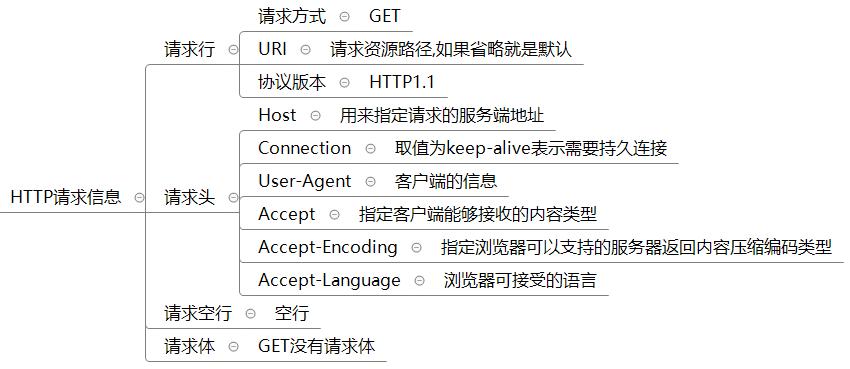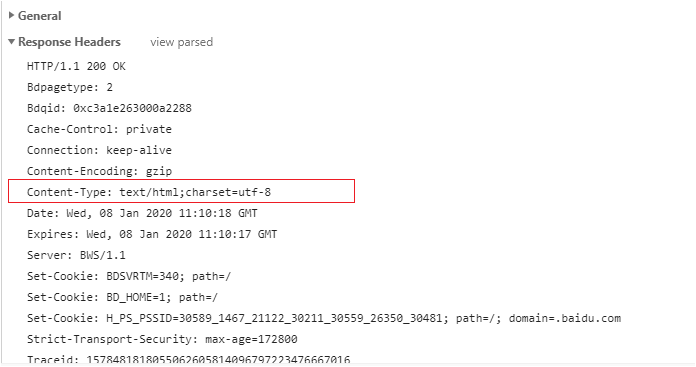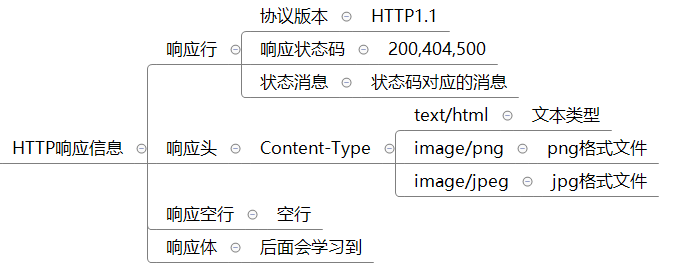HTTP协议
超文本传输协议(关于超文本的概念JavaWeb在进行学习),是建立在TCP/IP协议基础上,是网络应用层的协议。
由请求和响应构成,是一个标准的客户端和服务器模型
-
统一资源定位符,常见的如http://bbs.itheima.com/forum.php
-

-
在谷歌浏览器网页中按F12 或者网页空白处右键,点击检查,可以调出工具
-
点击network,进入到查看网络相关信息界面
-
-
-
请求行
-
请求头
-
请求空行
-
请求体
-
-
请求行
-
格式
-

-
GET,POST,HEAD,PUT,DELETE,CONNECT,OPTIONS,TRACE,PATCH
其中用的比较多的是GET和POST
-
URI
-
HTTP1.0: 每次请求和响应都需要建立一个单独的连接
-

-
Host: 用来指定请求的服务端地址
-
Connection: 取值为keep-alive表示需要持久连接
-
User-Agent: 客户端的信息
-
Accept: 指定客户端能够接收的内容类型
-
Accept-Encoding: 指定浏览器可以支持的服务器返回内容压缩编码类型
-

小结

-
-
响应行
-
响应头
-
响应空行
-
响应体
-
-
响应行
-
格式
-

-
-
-
HTTP1.0: 每次请求和响应都需要建立一个单独的连接
-
HTTP1.1: 支持长连接
-
-
响应状态码
-
1xx: 指示信息(表示请求已接收,继续处理)
-
2xx: 成功(表示请求已被成功接收、理解、接受)
-
3xx: 请求重定向(要完成请求必须进行更进一步的操作)
-
4xx: 客户端错误(请求有语法错误或请求无法实现)
-
5xx: 服务器端错误(服务器未能实现合法的请求)
-
-
状态信息
-
200 ok
-
404 Not Found
-
500 Internal Server Error
-
-
-
响应头
-
响应头名称
-
Content-Type: 告诉客户端实际返回内容的网络媒体类型(互联网媒体类型,也叫做MIME类型)
-
-
响应头值
-
text/html ----> 文本类型
-
image/png ----> png格式文件
-
-
-

小结

-
-
编写HttpServer类,实现可以接收浏览器发出的请求
-
其中获取连接的代码可以单独抽取到一个类中
-

// 服务端代码 public class HttpServer { public static void main(String[] args) throws IOException { //1.打开服务端通道 ServerSocketChannel serverSocketChannel = ServerSocketChannel.open(); //2.让这个通道绑定一个端口 serverSocketChannel.bind(new InetSocketAddress(10000)); //3.设置通道为非阻塞 serverSocketChannel.configureBlocking(false); //4.打开一个选择器 Selector selector = Selector.open(); //5.绑定选择器和服务端通道 serverSocketChannel.register(selector,SelectionKey.OP_ACCEPT); while(true){ //6.选择器会监视通道的状态. int count = selector.select(); if(count != 0){ //7.会遍历所有的服务端通道.看谁准备好了,谁准备好了,就让谁去连接. //获取所有服务端通道的令牌,并将它们都放到一个集合中,将集合返回. Set<SelectionKey> selectionKeys = selector.selectedKeys(); Iterator<SelectionKey> iterator = selectionKeys.iterator(); while(iterator.hasNext()){ //selectionKey 依次表示每一个服务端通道的令牌 SelectionKey selectionKey = iterator.next(); if(selectionKey.isAcceptable()){ //获取连接 AcceptHandler acceptHandler = new AcceptHandler(); acceptHandler.connSocketChannel(selectionKey); }else if(selectionKey.isReadable()){ } //任务处理完毕以后,将SelectionKey从集合中移除 iterator.remove(); } } } } } // 将获取连接的代码抽取到这个类中 public class AcceptHandler { public SocketChannel connSocketChannel(SelectionKey selectionKey){ try { //获取到已经就绪的服务端通道 ServerSocketChannel ssc = (ServerSocketChannel) selectionKey.channel(); SocketChannel socketChannel = ssc.accept(); //设置为非阻塞状态 socketChannel.configureBlocking(false); //把socketChannel注册到选择器上 socketChannel.register(selectionKey.selector(), SelectionKey.OP_READ); return socketChannel; } catch (IOException e) { e.printStackTrace(); } return null; } }
-
-
将请求信息封装到HttpRequest类中
-
在类中定义方法,实现获取请求信息并解析
-

/** * 用来封装请求数据的类 */ public class HttpRequest { private String method; //请求方式 private String requestURI; //请求的uri private String version; //http的协议版本 private HashMap<String,String> hm = new HashMap<>();//所有的请求头 //parse --- 获取请求数据 并解析 public void parse(SelectionKey selectionKey){ try { SocketChannel socketChannel = (SocketChannel) selectionKey.channel(); StringBuilder sb = new StringBuilder(); //创建一个缓冲区 ByteBuffer byteBuffer = ByteBuffer.allocate(1024); int len; //循环读取 while((len = socketChannel.read(byteBuffer)) > 0){ byteBuffer.flip(); sb.append(new String(byteBuffer.array(),0,len)); //System.out.println(new String(byteBuffer.array(),0,len)); byteBuffer.clear(); } //System.out.println(sb); parseHttpRequest(sb); } catch (IOException e) { e.printStackTrace(); } } //解析http请求协议中的数据 private void parseHttpRequest(StringBuilder sb) { //1.需要把StringBuilder先变成一个字符串 String httpRequestStr = sb.toString(); //2.获取每一行数据 String[] split = httpRequestStr.split("\r\n"); //3.获取请求行 String httpRequestLine = split[0];//GET / HTTP/1.1 //4.按照空格进行切割,得到请求行中的三部分 String[] httpRequestInfo = httpRequestLine.split(" "); this.method = httpRequestInfo[0]; this.requestURI = httpRequestInfo[1]; this.version = httpRequestInfo[2]; //5.操作每一个请求头 for (int i = 1; i < split.length; i++) { String httpRequestHeaderInfo = split[i];//Host: 127.0.0.1:10000 String[] httpRequestHeaderInfoArr = httpRequestHeaderInfo.split(": "); hm.put(httpRequestHeaderInfoArr[0],httpRequestHeaderInfoArr[1]); } } public String getMethod() { return method; } public void setMethod(String method) { this.method = method; } public String getRequestURI() { return requestURI; } public void setRequestURI(String requestURI) { this.requestURI = requestURI; } public String getVersion() { return version; } public void setVersion(String version) { this.version = version; } public HashMap<String, String> getHm() { return hm; } public void setHm(HashMap<String, String> hm) { this.hm = hm; } @Override public String toString() { return "HttpRequest{" + "method='" + method + '\'' + ", requestURI='" + requestURI + '\'' + ", version='" + version + '\'' + ", hm=" + hm + '}'; } }
-
-
将响应信息封装HttpResponse类中
-
定义方法,封装响应信息,给浏览器响应数据
-

public class HttpResponse { private String version; //协议版本 private String status; //响应状态码 private String desc; //状态码的描述信息 //响应头数据 private HashMap<String, String> hm = new HashMap<>(); private HttpRequest httpRequest; //我们后面要根据请求的数据,来进行一些判断 //给浏览器响应数据的方法 public void sendStaticResource(SelectionKey selectionKey) { //1.给响应行赋值 this.version = "HTTP/1.1"; this.status = "200"; this.desc = "ok"; //2.将响应行拼接成一个单独的字符串 // HTTP/1.1 200 ok String responseLine = this.version + " " + this.status + " " + this.desc + "\r\n"; //3.给响应头赋值 hm.put("Content-Type", "text/html;charset=UTF-8"); //4.将所有的响应头拼接成一个单独的字符串 StringBuilder sb = new StringBuilder(); Set<Map.Entry<String, String>> entries = hm.entrySet(); for (Map.Entry<String, String> entry : entries) { sb.append(entry.getKey()).append(": ").append(entry.getValue()).append("\r\n"); } //5.响应空行 String emptyLine = "\r\n"; //6.响应行,响应头,响应空行拼接成一个大字符串 String responseLineStr = responseLine + sb.toString() + emptyLine; try { //7.将上面三个写给浏览器 SocketChannel socketChannel = (SocketChannel) selectionKey.channel(); ByteBuffer byteBuffer1 = ByteBuffer.wrap(responseLineStr.getBytes()); socketChannel.write(byteBuffer1); //8.单独操作响应体 //因为在以后响应体不一定是一个字符串 //有可能是一个文件,所以单独操作 String s = "哎哟,妈呀,终于写完了."; ByteBuffer byteBuffer2 = ByteBuffer.wrap(s.getBytes()); socketChannel.write(byteBuffer2); //9.释放资源 socketChannel.close(); } catch (IOException e) { e.printStackTrace(); } } public String getVersion() { return version; } public void setVersion(String version) { this.version = version; } public String getStatus() { return status; } public void setStatus(String status) { this.status = status; } public String getDesc() { return desc; } public void setDesc(String desc) { this.desc = desc; } public HashMap<String, String> getHm() { return hm; } public void setHm(HashMap<String, String> hm) { this.hm = hm; } public HttpRequest getHttpRequest() { return httpRequest; } public void setHttpRequest(HttpRequest httpRequest) { this.httpRequest = httpRequest; } @Override public String toString() { return "HttpResponse{" + "version='" + version + '\'' + ", status='" + status + '\'' + ", desc='" + desc + '\'' + ", hm=" + hm + ", httpRequest=" + httpRequest + '}'; } }
-
-
根据请求资源路径不同,响应不同的数据
-
服务端健壮性处理
-
访问不存在的资源处理
-

/** * 接收连接的任务处理类 */ public class AcceptHandler { public SocketChannel connSocketChannel(SelectionKey selectionKey){ try { //获取到已经就绪的服务端通道 ServerSocketChannel ssc = (ServerSocketChannel) selectionKey.channel(); SocketChannel socketChannel = ssc.accept(); //设置为非阻塞状态 socketChannel.configureBlocking(false); //把socketChannel注册到选择器上 socketChannel.register(selectionKey.selector(), SelectionKey.OP_READ); return socketChannel; } catch (IOException e) { e.printStackTrace(); } return null; } } /** * 接收客户端请求的类 */ public class HttpServer { public static void main(String[] args) throws IOException { //1.打开服务端通道 ServerSocketChannel serverSocketChannel = ServerSocketChannel.open(); //2.让这个通道绑定一个端口 serverSocketChannel.bind(new InetSocketAddress(10000)); //3.设置通道为非阻塞 serverSocketChannel.configureBlocking(false); //4.打开一个选择器 Selector selector = Selector.open(); //5.绑定选择器和服务端通道 serverSocketChannel.register(selector,SelectionKey.OP_ACCEPT); while(true){ //6.选择器会监视通道的状态. int count = selector.select(); if(count != 0){ //7.会遍历所有的服务端通道.看谁准备好了,谁准备好了,就让谁去连接. //获取所有服务端通道的令牌,并将它们都放到一个集合中,将集合返回. Set<SelectionKey> selectionKeys = selector.selectedKeys(); Iterator<SelectionKey> iterator = selectionKeys.iterator(); while(iterator.hasNext()){ //selectionKey 依次表示每一个服务端通道的令牌 SelectionKey selectionKey = iterator.next(); if(selectionKey.isAcceptable()){ //获取连接 AcceptHandler acceptHandler = new AcceptHandler(); acceptHandler.connSocketChannel(selectionKey); }else if(selectionKey.isReadable()){ //读取数据 HttpRequest httpRequest = new HttpRequest(); httpRequest.parse(selectionKey); System.out.println("http请求的数据为 ---->" + httpRequest); if(httpRequest.getRequestURI() == null || "".equals(httpRequest.getRequestURI())){ selectionKey.channel(); continue; } System.out.println("...数据解析完毕,准备响应数据...."); //响应数据 HttpResponse httpResponse = new HttpResponse(); httpResponse.setHttpRequest(httpRequest); httpResponse.sendStaticResource(selectionKey); } //任务处理完毕以后,将SelectionKey从集合中移除 iterator.remove(); } } } } } /** * 用来封装请求数据的类 */ public class HttpRequest { private String method; //请求方式 private String requestURI; //请求的uri private String version; //http的协议版本 private HashMap<String,String> hm = new HashMap<>();//所有的请求头 //parse --- 获取请求数据 并解析 public void parse(SelectionKey selectionKey){ try { SocketChannel socketChannel = (SocketChannel) selectionKey.channel(); StringBuilder sb = new StringBuilder(); //创建一个缓冲区 ByteBuffer byteBuffer = ByteBuffer.allocate(1024); int len; //循环读取 while((len = socketChannel.read(byteBuffer)) > 0){ byteBuffer.flip(); sb.append(new String(byteBuffer.array(),0,len)); //System.out.println(new String(byteBuffer.array(),0,len)); byteBuffer.clear(); } //System.out.println(sb); parseHttpRequest(sb); } catch (IOException e) { e.printStackTrace(); } } //解析http请求协议中的数据 private void parseHttpRequest(StringBuilder sb) { //1.需要把StringBuilder先变成一个字符串 String httpRequestStr = sb.toString(); if(!(httpRequestStr == null || "".equals(httpRequestStr))){ //2.获取每一行数据 String[] split = httpRequestStr.split("\r\n"); //3.获取请求行 String httpRequestLine = split[0];//GET / HTTP/1.1 //4.按照空格进行切割,得到请求行中的三部分 String[] httpRequestInfo = httpRequestLine.split(" "); this.method = httpRequestInfo[0]; this.requestURI = httpRequestInfo[1]; this.version = httpRequestInfo[2]; //5.操作每一个请求头 for (int i = 1; i < split.length; i++) { String httpRequestHeaderInfo = split[i];//Host: 127.0.0.1:10000 String[] httpRequestHeaderInfoArr = httpRequestHeaderInfo.split(": "); hm.put(httpRequestHeaderInfoArr[0],httpRequestHeaderInfoArr[1]); } } } public String getMethod() { return method; } public void setMethod(String method) { this.method = method; } public String getRequestURI() { return requestURI; } public void setRequestURI(String requestURI) { this.requestURI = requestURI; } public String getVersion() { return version; } public void setVersion(String version) { this.version = version; } public HashMap<String, String> getHm() { return hm; } public void setHm(HashMap<String, String> hm) { this.hm = hm; } @Override public String toString() { return "HttpRequest{" + "method='" + method + '\'' + ", requestURI='" + requestURI + '\'' + ", version='" + version + '\'' + ", hm=" + hm + '}'; } } /** * 用来封装响应数据的类 */ public class HttpResponse { private String version; //协议版本 private String status; //响应状态码 private String desc; //状态码的描述信息 //响应头数据 private HashMap<String, String> hm = new HashMap<>(); private HttpRequest httpRequest; //我们后面要根据请求的数据,来进行一些判断 //给浏览器响应数据的方法 public void sendStaticResource(SelectionKey selectionKey) { //1.给响应行赋值 this.version = "HTTP/1.1"; this.status = "200"; this.desc = "ok"; //3.给响应头赋值 //先获取浏览器请求的URI String requestURI = this.getHttpRequest().getRequestURI(); if(requestURI != null){ File file = new File(WEB_APP_PATH + requestURI); //判断这个路径是否存在 if(!file.exists()){ this.status = "404"; this.desc = "NOT FOUNG"; } if("200".equals(this.status)){ if("/".equals(requestURI)){ hm.put("Content-Type", "text/html;charset=UTF-8"); }else if("/favicon.ico".equals(requestURI)){ hm.put("Content-Type", "image/x-icon"); }else if("/a.txt".equals(requestURI)){ hm.put("Content-Type", "text/html;charset=UTF-8"); }else if("/1.jpg".equals(requestURI)){ hm.put("Content-Type", "image/jpeg"); }else if("/1.png".equals(requestURI)){ hm.put("Content-Type", "image/png"); } }else{ hm.put("Content-Type", "text/html;charset=UTF-8"); } } //2.将响应行拼接成一个单独的字符串 // HTTP/1.1 200 ok String responseLine = this.version + " " + this.status + " " + this.desc + "\r\n"; //4.将所有的响应头拼接成一个单独的字符串 StringBuilder sb = new StringBuilder(); Set<Map.Entry<String, String>> entries = hm.entrySet(); for (Map.Entry<String, String> entry : entries) { sb.append(entry.getKey()).append(": ").append(entry.getValue()).append("\r\n"); } //5.响应空行 String emptyLine = "\r\n"; //6.响应行,响应头,响应空行拼接成一个大字符串 String responseLineStr = responseLine + sb.toString() + emptyLine; try { //7.将上面三个写给浏览器 SocketChannel socketChannel = (SocketChannel) selectionKey.channel(); ByteBuffer byteBuffer1 = ByteBuffer.wrap(responseLineStr.getBytes()); socketChannel.write(byteBuffer1); //8.单独操作响应体 //因为在以后响应体不一定是一个字符串 //有可能是一个文件,所以单独操作 // String s = "哎哟,妈呀,终于写完了."; byte [] bytes = getContent(); ByteBuffer byteBuffer2 = ByteBuffer.wrap(bytes); socketChannel.write(byteBuffer2); //9.释放资源 socketChannel.close(); } catch (IOException e) { e.printStackTrace(); } } public static final String WEB_APP_PATH = "mynio\\webapp"; private byte[] getContent() { try { //1.获取浏览器请求的URI String requestURI = this.getHttpRequest().getRequestURI(); if(requestURI != null){ if("200".equals(this.status)){ //2.判断一下请求的URI,根据不同的URI来响应不同的东西 if("/".equals(requestURI)){ String s = "哎哟,妈呀,终于写完了."; return s.getBytes(); }else/* if("/favicon.ico".equals(requestURI))*/{ //获取一个ico文件 FileInputStream fis = new FileInputStream(WEB_APP_PATH + requestURI); //把ico文件变成一个字节数组返回 return IOUtils.toByteArray(fis); } }else{ return "访问的资源不存在".getBytes(); } } } catch (IOException e) { e.printStackTrace(); } return new byte[0]; } public String getVersion() { return version; } public void setVersion(String version) { this.version = version; } public String getStatus() { return status; } public void setStatus(String status) { this.status = status; } public String getDesc() { return desc; } public void setDesc(String desc) { this.desc = desc; } public HashMap<String, String> getHm() { return hm; } public void setHm(HashMap<String, String> hm) { this.hm = hm; } public HttpRequest getHttpRequest() { return httpRequest; } public void setHttpRequest(HttpRequest httpRequest) { this.httpRequest = httpRequest; } @Override public String toString() { return "HttpResponse{" + "version='" + version + '\'' + ", status='" + status + '\'' + ", desc='" + desc + '\'' + ", hm=" + hm + ", httpRequest=" + httpRequest + '}'; } }


